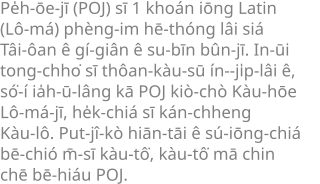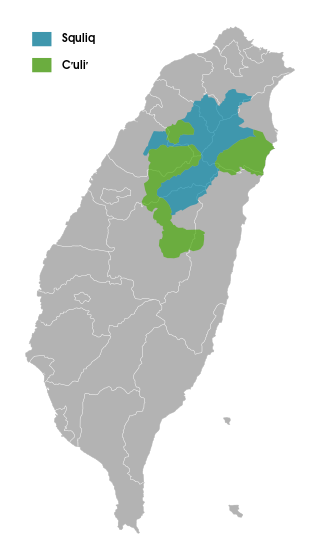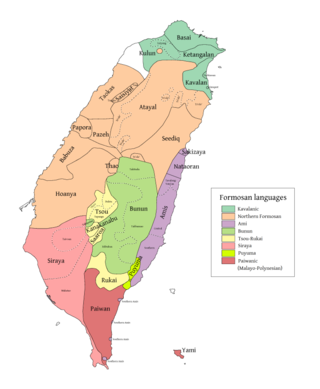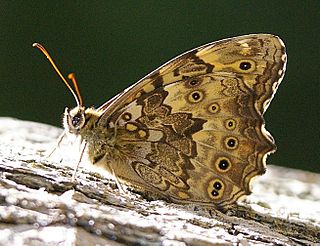
The Taiwan Strait is a 180-kilometer -wide strait separating the island of Taiwan and Asian continent. The strait is part of the South China Sea and connects to the East China Sea to the north. The narrowest part is 130 km wide.
Some Buddhist terms and concepts lack direct translations into English that cover the breadth of the original term. Below are given a number of important Buddhist terms, short definitions, and the languages in which they appear. In this list, an attempt has been made to organize terms by their original form and give translations and synonyms in other languages along with the definition.

Pe̍h-ōe-jī, sometimes known as Church Romanization, is an orthography used to write variants of Hokkien Southern Min, particularly Taiwanese and Amoy Hokkien, and it is widely employed as one of the writing systems for Southern Min. During its peak, it had hundreds of thousands of readers.

The Atayal language is an Austronesian language spoken by the Atayal people of Taiwan. Squliq and C’uli’ (Ts’ole’) are two major dialects. Mayrinax and Pa’kuali’, two subdialects of C’uli’, are unique among Atayal dialects in having male and female register distinctions in their vocabulary.

Kavalan was formerly spoken in the Northeast coast area of Taiwan by the Kavalan people (噶瑪蘭). It is an East Formosan language of the Austronesian family.

The Taiwan angelshark is an angelshark in the family Squatinidae. The Taiwan angelshark is one of four species of Squatina in the waters around Taiwan and Japan. It is a demersal, ray-like shark that grows to 1–2 meters in length.

Taiwanese kana is a katakana-based writing system that was used to write Taiwanese Hokkien when the island of Taiwan was under Japanese rule. It functioned as a phonetic guide to hanzi, much like furigana in Japanese or Zhuyin fuhao in Chinese. There were similar systems for other languages in Taiwan as well, including Hakka and Formosan languages.

Neope goschkevitschii is a Nymphalidae butterfly found in East Asia. This species looks quite similar to Neope niphonica and these two species were treated as one for a long time.
Neope pulahina, the scarce labyrinth, is a nymphalid butterfly found in India and South Asia.

The official romanization system for Taiwanese Hokkien in Taiwan is locally referred to as Tâi-uân Bân-lâm-gí Lô-má-jī Phing-im Hong-àn or Taiwan Minnanyu Luomazi Pinyin Fang'an, often shortened to Tâi-lô. It is derived from Pe̍h-ōe-jī and since 2006 has been one of the phonetic notation systems officially promoted by Taiwan's Ministry of Education. The system is used in the MoE's Dictionary of Frequently-Used Taiwan Minnan. It is nearly identical to Pe̍h-ōe-jī, apart from: using ts tsh instead of ch chh, using u instead of o in vowel combinations such as oa and oe, using i instead of e in eng and ek, using oo instead of o͘, and using nn instead of ⁿ.

Neope bhadra is a nymphalid butterfly known from Asia, where it is found from Sikkim to Upper Burma.

Neope yama, the dusky labyrinth, is a species of satyrine butterfly found in Asia. In the Himalayas it is common from the eastern Himalayas to eastern Nepal and less common from western Nepal to Himachal Pradesh.

Neope armandii is a species of satyrine butterfly found in Asia.

Neope pulaha, the veined labyrinth, is a species of satyrine butterfly found in Asia.

Taiwanese Braille is the braille script used in Taiwan for Taiwanese Mandarin (Guoyu). Although based marginally on international braille, most consonants have been reassigned; also, like Chinese Braille, Taiwanese Braille is a semi-syllabary.

Neope is a genus of butterflies of the family Nymphalidae found in Asia.

The World Turned Upside Down is a sculpture by the Turner Prize-winning artist Mark Wallinger, on Sheffield Street, London, within the campus of the London School of Economics. The name World Turned Upside Down comes from a 17th-century English ballad. The sculpture, measuring 13 feet (4 m) in diameter, features a globe resting on its North Pole and was unveiled in March 2019. It reportedly cost over £200,000, which was funded by alumni donations.















